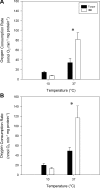Reversible temperature-dependent differences in brown adipose tissue respiration during torpor in a mammalian hibernator
- PMID: 28077390
- PMCID: PMC5401996
- DOI: 10.1152/ajpregu.00316.2016
Reversible temperature-dependent differences in brown adipose tissue respiration during torpor in a mammalian hibernator
Abstract
Although seasonal modifications of brown adipose tissue (BAT) in hibernators are well documented, we know little about functional regulation of BAT in different phases of hibernation. In the 13-lined ground squirrel, liver mitochondrial respiration is suppressed by up to 70% during torpor. This suppression is reversed during arousal and interbout euthermia (IBE), and corresponds with patterns of maximal activities of electron transport system (ETS) enzymes. Uncoupling of BAT mitochondria is controlled by free fatty acid release stimulated by sympathetic activation of adipocytes, so we hypothesized that further regulation at the level of the ETS would be of little advantage. As predicted, maximal ETS enzyme activities of isolated BAT mitochondria did not differ between torpor and IBE. In contrast to this pattern, respiration rates of mitochondria isolated from torpid individuals were suppressed by ~60% compared with rates from IBE individuals when measured at 37°C. At 10°C, however, mitochondrial respiration rates tended to be greater in torpor than IBE. As a result, the temperature sensitivity (Q10) of mitochondrial respiration was significantly lower in torpor (~1.4) than IBE (~2.4), perhaps facilitating energy savings during entrance into torpor and thermogenesis at low body temperatures. Despite the observed differences in isolated mitochondria, norepinephrine-stimulated respiration rates of isolated BAT adipocytes did not differ between torpor and IBE, perhaps because the adipocyte isolation requires lengthy incubation at 37°C, potentially reversing any changes that occur in torpor. Such changes may include remodeling of BAT mitochondrial membrane phospholipids, which could change in situ enzyme activities and temperature sensitivities.
Keywords: Q10; electron transport system; hibernation; mitochondria; uncoupled thermogenesis.
Copyright © 2017 the American Physiological Society.
Figures







References
-
- Brown JC, Chung DJ, Belgrave KR, Staples JF. Mitochondrial metabolic suppression and reactive oxygen species production in liver and skeletal muscle of hibernating thirteen-lined ground squirrels. Am J Physiol Regul Integr Comp Physiol 302: R15–R28, 2012. doi:10.1152/ajpregu.00230.2011. - DOI - PubMed
Publication types
MeSH terms
LinkOut - more resources
Full Text Sources
Other Literature Sources
Research Materials

